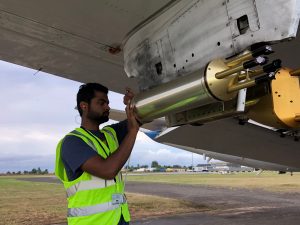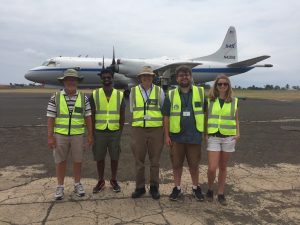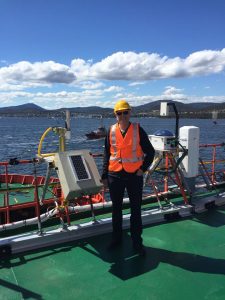January 2023:  Graduate student Peter Brechner and undergraduate students Ethan Schaefer and Julian Schima pose in front of the NASA P-3 aircraft before a flight to sample winter storms during the NASA Investigations of Microphysics and Precipitation for Atlantic Coast-Threatening Snowstorms (IMPACTS) project. Data collected during this campaign will provide valuable information to improve modeling and remote sensing of winter storms.
Graduate student Peter Brechner and undergraduate students Ethan Schaefer and Julian Schima pose in front of the NASA P-3 aircraft before a flight to sample winter storms during the NASA Investigations of Microphysics and Precipitation for Atlantic Coast-Threatening Snowstorms (IMPACTS) project. Data collected during this campaign will provide valuable information to improve modeling and remote sensing of winter storms.
December 2022: 
Members of the cloud physics group in Chicago at dinner following presentations at the 2022 American Geophysical Union fall meeting.
June 2022:

A group photo showing all the personnel (many from the OU cloud physics group) and assets used during the 2022 NSF-funded Experiment of Sea Breeze Convection, Aerosols, Precipitation, and Environment (ESCAPE) field campaign. Data collected during this experiment will help us understand the influence of dynamics and aerosols on the evolution of isolated convective storms.
April 2022:

Current and past members of the cloud physics group assemble for a spring dinner and get together.
February 2022:

The OU cloud physics group resumes their participation in research flights after a pause during the pandemic. The NASA Investigations of Microphysics and Precipitation for Atlantic Coast-Threatening Snowstorms (IMPACTS) project is taking place based out of NASA Wallops. Data collected during this campaign will provide valuable information to improve modeling and remote sensing of winter storms.
December 2021:

In-person conference participation of the cloud physics group resumes at the 2021 Annual Meeting of the American Geophysical Union in New Orleans, LA.
October 2018: Graduate student Siddhant Gupta is seen readying a cloud probe
 before a flight of the NASA P-3 during the Observations of Aerosols Above Clouds and their Interactions (ORACLES) field experiment based out of São Tomé in Africa. Siddhant along with other members of the McFarquhar group (Rose Miller and Greg McFarquhar) participated in this experiment which will provide invaluable data about how biomass burning from the African continent affect the properties of clouds off the west coast of Africa, ultimately allowing us to improve Earth system models and satellite retrievals of cloud properties.
before a flight of the NASA P-3 during the Observations of Aerosols Above Clouds and their Interactions (ORACLES) field experiment based out of São Tomé in Africa. Siddhant along with other members of the McFarquhar group (Rose Miller and Greg McFarquhar) participated in this experiment which will provide invaluable data about how biomass burning from the African continent affect the properties of clouds off the west coast of Africa, ultimately allowing us to improve Earth system models and satellite retrievals of cloud properties.


